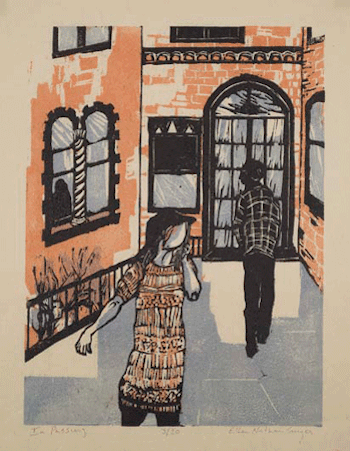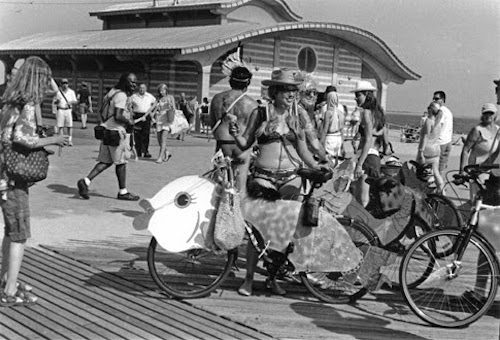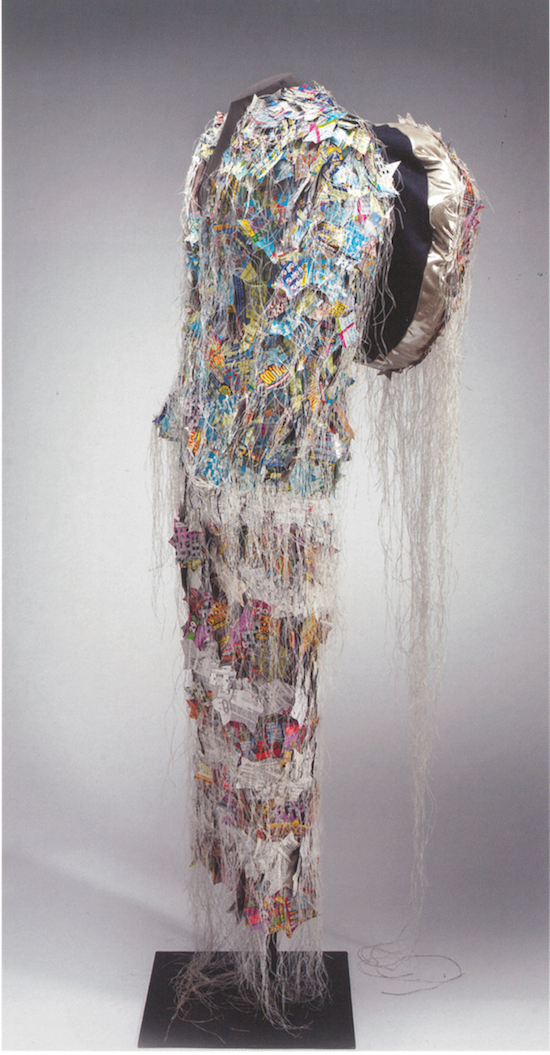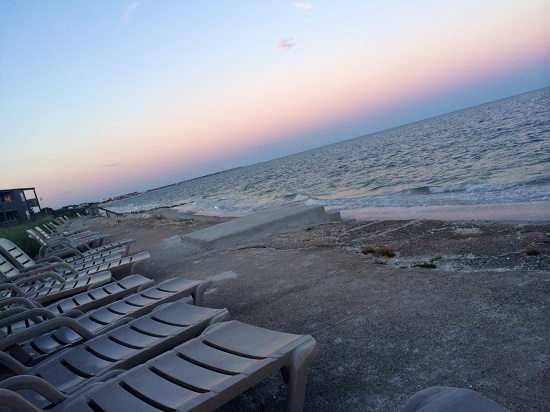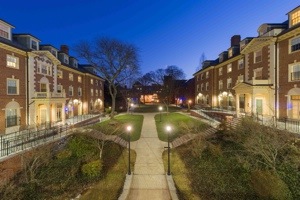Robert Whitcomb: Another trap in the energy cycles
A few years ago I co-wrote a book, with Wendy Williams, about a controversy centered on Nantucket Sound. The quasi-social comedy, called Cape Wind: Money, Celebrity, Energy, Class, Politics and the Battle for Our Energy Future, told of how, since 2001, a company led by entrepreneur James Gordon has struggled to put up a wind farm in the sound in the face of opposition from the Alliance to Protect Nantucket Sound — a long name for fossil-fuel billionaire Bill Koch, a member of the famous right-wing Republican family. An amusing movie, Cape Spin, directed by John Kirby and produced by Libby Handros, came out of this saga, too. Mr. Koch's houses include a summer mansion in Osterville, Mass., from which he doesn’t want to see wind turbines on his southern horizon on clear days.
Mr. Koch may now have won the battle, as very rich people usually do. Two big utilities, National Grid and Northeast Utilities, are trying to bail out of a politicized plan, which they never liked, forcing them to buy Cape Wind electricity. They cite the fact that the company missed the Dec. 31, 2014, deadline in contracts signed in 2012 to obtain financing and start construction. Cape Wind said it doesn’t “regard these terminations as valid” since, it asserts, the contracts let the utilities’ contracts be extended because of the alliance’s “unprecedented and relentless litigation.” Bill Koch has virtually unlimited funds to pay lawyers to litigate unto the Second Coming, aided by imaginative rhetoric supplied by his very smart and well paid pit-bull anti-Cape Wind spokeswoman, Audra Parker, even though the project has won all regulatory approvals.
It's no secret that it has gotten harder and harder to do big projects in the United States because of endless litigation and ever more layers of regulation. Thus our physical infrastructure --- electrical grid, transportation and so on -- continues to fall behind our friendly competitors, say in the European Union and Japan, and our not-so-friendly competitors, especially in China. Read my friend Philip K. Howard's latest book, The Rule of Nobody, on this.
With the death of Cape Wind, New Englanders would lose what could have helped diversify the region’s energy mix — and smooth out price and supply swings — with home-grown, renewable electricity. Cape Wind is far from a panacea for the region’s dependence on natural gas, oil and nuclear, but it would add a tad more security.
Some of Cape Wind’s foes will say that the natural gas from fracking will take care of everything. But New England lacks adequate natural-gas pipeline capacity, to no small extent because affluent people along the routes hold up their construction. And NIMBYs (not in my backyard) have also blocked efforts to bring in more Canadian hydro-electric power. So our electricity rates are soaring, even as many of those who complain about the rates also fight any attempt to put new energy infrastructure near them. As for nuclear, it seems too politically incorrect for it to be expanded again in New England.
Meanwhile, the drawbacks to fracking, including water pollution and earthquakes in fracked countryside, are becoming more obvious. And the gas reserves may well be exaggerated. I support fracking anyway, since it means less use of oil and coal and because much of the gas is nearby, in Pennsylvania. (New York, however, recently banned fracking.)
Get ready for brownouts and higher electricity bills. As for oil prices, they are low now, but I have seen many, many energy price cycles over the last 45 years of watching the sector. And they often come with little warning. But meanwhile, many Americans, with ever-worsening amnesia, flock to buy SUV's again.
Robert Whitcomb oversees New England Diary.
Nausea and nostalgia
"Mermaid Parade at Coney Island,'' by EMILY CORBATO, in her show "Glorious Women,'' in the Firehouse Art Gallery, Newburyport, Mass., through Sept. 7.
Whenever I see a picture of an oceanfront amusement park I think of the nausea produced by eating great quantities of cotton candy and riding on roller coasters that would not pass muster by the Occupational Safety and Health Administration.
--Robert Whitcomb
Firehouse Center for the Arts features Emily Corbato's photography exhibit, "Glorious Women" in the Firehouse Art Gallery through September 7. Meet the Artist during ArtWalk on Saturday, August 16, 3:30 - 5:30 PM. Corbato's black and white photography documents women from many parts of the world, all engaged in ordinary daily activities. The universality of women's lives is apparent: in a city in Peru, or New York, or Martha's Vinyeard; sewing, shopping, laughing, enjoying Plum Island, Disneyland or Coney Island, the location on the g
Floss daily and keep hoping
"Captain America Suit'' (found lottery tickets, dental floss. man's suit), by REBECCA SIERMERING, in the traveling Fiberart International show, which will be at the American Textile History Museum, in Lowell, Mass., through Oct. 26. The museum say she says that the work ''reflects our yearning for a quick path to 'the good life.'''
Making textiles and the clothes that are are made of them used to be a very big deal in New England, especially in such old mill towns as Lowell. Now little of that stuff is made in our six states, but we still appreciate the art associated with it. Lowell, with its beautiful mills, canals and other reminders of its glory as a textile town, much preserved in the Lowell National Historical Park, is well worth a visit. It's a way of understanding the ingenuity and dynamism that marked the American Industrial Revolution. (Then there were the horrors of child labor....)
Healing a health system together
(I have been working with Cambridge Management Group. I found this project, involving health care in some old mill cities and smaller communities in north-central Massachusetts surrounded by some lovely countryside, particularly interesting.)
-- Robert Whitcomb
By Yvonne C. Acquafredda, MBA, and Lillian J. LeBlanc, MBA
Today’s healthcare organizations face increased pressure to deliver high-quality and cost-effective care. A key element in enabling them to do this is creating work environments that encourage teamwork on all levels, from board members to all employees.
The Great Place to Work Institute, which studies organizations around the globe, notes the importance of collaboration in the workplace. Great enterprises of all sizes structure their operations to encourage employee cooperation to achieve their organizations’ goals.
Fitchburg, Mass.-based Community Health Connections (CHC), a system of outpatient clinics providing medical, dental and behavioral-health services to thousands of mostly low-income residents in 20 communities, achieved an operational turnaround through a new focus on cross-functional cooperation and clearer and more consistent management.
This was accomplished in partnership with the healthcare-sector consultancy Cambridge Management Group (CMG) and the executive-search firm ZurickDavis (ZD).
CHC is a Federally Qualified Health Center (FQHC). With changing demographics and healthcare reform, such institutions play an increasingly important role in the U.S. healthcare sector. CHC’s experience has lessons for a wide range of healthcare and other organizations across America.
Established just 10 years ago, CHC grew rapidly as it responded to urgent needs to provide primary care in north-central Massachusetts. As patient volume increased, clinicians and administrators worked diligently to meet the demand. But CHC’s organizational structure and culture acted as barriers to examining and improving business processes even as clinical demands surged. By 2013, CHC found itself near receivership. As CHC board member Gregg Buckman put it, “the financial issues were staggering.” In addition, employee morale fell to an all-time low.
Would CHC collapse in the face of the demands being put on it?
Cambridge Management Group Transforms the Organization
Fortunately, CHC’s forward-thinking board recognized the broad range of issues facing the organization and contacted CMG to find ways to stop the losses and then stabilize, focus and grow the organization.
Crucial parts of the engagement that followed were to emphasize collaboration at all levels and to clarify the institution’s needs and goals.
CMG typically operates as a partner of management, providing guidance, expertise and best practices learned over the company’s three decades. As Lia Spiliotes, a CMG partner and senior adviser, explained: “We don’t do what you do; we help you do what you do better.”
However, due to the depth of the challenges at CHC, the board and CMG agreed that interim leadership was needed. Thus Ms. Spiliotes became interim CEO and her CMG colleague Kevin Ward interim CFO.
CMG brought its corporate philosophy of servant leadership to CHC, emphasizing executive approachability and openness without all the traditional boundaries of organizational hierarchy. For example, before CMG’s arrival, CHC executive offices were in an area of CHC headquarters removed from most employees and patients. The interim leadership team established its base in a former gift shop called “The Fishbowl,” in the middle of CHC’s main building. All employees were welcomed to come by.
Another example of this approach was that Ms. Spiliotes invited CHC billing people to meet with the interim leadership team, to give the latter perspective on CHC’s billing processes and present ideas for improvement.
In the initial meetings, all employees were quiet, seemingly afraid to speak up. But over time, as staffers observed, and regularly interacted with, the interim leaders, candid discussion helped to reveal several core operational challenges. One, identified by the billing team, was a communication breakdown between the clinical and billing departments, resulting in many claims being denied. Absent cross-functional teams, the communication changes needed to capture lost revenue would never have been identified.
Over the months of CMG’s leadership, through regular communication and increased collaboration, employees identified many administrative, financial and clinical concerns. Workable solutions were designed in response as the newly collaborative process led employees to feel more empowered, energized and invested in CHC’s success. ZurickDavis Leverages Collaboration for the CEO Search
As a new culture took hold, the CHC board turned considerable attention to recruiting a long-term leadership team. Sustaining CHC’s turnaround would require leaders with the same understanding of servant leadership that CMG brought, able to relate to employees at all levels and willing to invest the skills, time and energy needed to support organization-wide collaboration to achieve operational success.
So CHC’s board reached out to a trusted business partner, the executive-search firm ZurickDavis. CMG and ZD had been familiar with each other’s work for years.
In the spirit of collaboration, so much a hallmark of the CMG-ZD engagement, the latter’s staff invested considerable time to understand the needs of the organization, including requirements for new leadership. ZD went beyond standard job descriptions and the conventional executive-search process; it approached the engagement with few assumptions. It intensely interviewed several CHC board members and the interim leadership team, letting ZD come to fully understand the organization’s evolution and needs.
Armed with this information, ZD developed a profile of the ideal CEO to maintain CHC’s momentum. Through careful listening to the stakeholders, ZD recognized that certain qualities of character would be even more important than very job-specific skills. The new leader must be someone “committed to serve, unpretentious and genuine,” ZD found. He or she should possess a “naturally respectful, consultative, collaborative and accessible leadership style,” but also show “a willingness to lead decisively, to energize and inspire.”
ZD was a full partner throughout the process. According to ZurickDavis’s Ellen Mahoney, who worked closely in the search, steady openness and collaboration informed the whole process. “Everyone was transparent. We were a part of all meetings and fully utilized as a resource.”
Jeff Zegas, ZD’s chief executive officer, said that this level of cooperation and candor, especially in hiring a new leader, is crucial to any organization wishing to strengthen its culture and thus achieve and maintain operational success over the long term.
Building a Collaborative Organization: The ROI
Although CHC’s transformation is still a work in progress, outcomes show the positive impact of the CMG-ZD engagement. CHC achieved a positive fiscal 2013 cash flow (before depreciation) of nearly $190,000, compared with a negative $1.2 million for fiscal 2011. Eligibility denials involving erroneously entered insurance claims were reduced by almost 65%. And the organization enjoyed unprecedented public support for its $20 million project to build a new Fitchburg Family Health Center.
However, much still remains to be done. CHC’s board chair, Mary Giannetti, offers this advice to other organizations that need to effect profound change. “It takes commitment at all levels, but you don’t have to do it alone. Call in the experts and place trust in those you hire.” CMG co-founder Bob Harrington sums up the process at CHC: “Give employees some autonomy and expectation of accountability and you will motivate them to succeed.”
Yvonne Acquafredda has provided broad-based marketing and communications support to several companies in consumer services and healthcare. She has extensive experience in multi-site organizations. Ms. Acquafredda has a bachelor of science degree in communications from the University of Miami, a master of business administration degree from Northeastern University and a certificate in digital marketing from Rutgers University.
Lillian LeBlanc has more than 30 years of experience in the healthcare industry, assisting organizations with cultural transformation and boosting organizational effectiveness. She has worked with healthcare systems in Boston, Maine and South Florida. Ms LeBlanc holds a bachelor of science degree in economics, summa cum laude, from Boston State College and a master of business administration degree from the University of Massachusetts. She is a guest blogger for the Great Place to Work Institute, which produces Fortune’s annual list of 100 Best Places to Work For in America.
Somali resettlement: 'Poverty on top of poverty'
The mayor of Springfield, Mass., Domenic Sarno, is angry that the federal government keeps sending Somali refugees to his city, where a third of the population is below the poverty line. I don't blame him. "I have enough urban issues to deal with. Enough is enough. You can't keep concentrating poverty on top of poverty,'' he told the Associated Press.
A lot of these people (who tend to have big families) live in overcrowded apartments that sometimes lack electricity and even heat. The mayor complained that resettlement agencies are bringing "warm-weather'' refugees into cold climates to live.
Somalis started coming to Springfield in large numbers in 2004, pushed by federal officials who directed them to places with urban infrastructure, including mass transit (essential for many people to get to jobs). The more who live there, of course, the more who come, to be with families and friends. Most of the adults have jobs. But, of course, especially with large families, many also need social services.
A Boston Globe editorial criticized the mayor for ignoring "the moral imperative to help refugees and the benefits those refugees can bring.''
But The Globe's editorial board doesn't spend a lot of time in poor communities such as Springfield. Maybe their criticism would have more weight if they pushed for such affluent towns as Wellesley to take in Somali refugees.
Challenges to clinics
Last fall, when I was writing about my Cambridge Management Group (CMG) colleagues' work in helping to turn around a financially troubled Federally Qualified Health Center (FQHC) called Community Health Connections, based in Fitchburg, Mass., I learned about the role these centers play in addressing changing American health-care demographics in general and illness — especially chronic illness — in low-income populations in particular. Such centers will continue to face reimbursement and other issues as the restructuring of the health sector accelerates. The Affordable Care Act, in increasing the emphasis on primary care while more closely integrating it with acute care, will almost certainly increase the importance of FQHC’s and other clinics. With all the publicity about trying to get everyone signed up for insurance to use at physicians' offices and hospitals, we should keep in mind the need for facilities that are neither hospitals nor physician-group offices in treating underserved populations in places like the old mill towns of north central Massachusetts, with their high incidence of poor behavioral health and such related chronic diseases as diabetes, and sluggish economies.
Such institutions will have their hands full overcoming the clinical, financial and administrative challenges of meeting new federal and state health-care reform mandates while refocusing the payment structure on fee for value and away from fee for service in a new, far more accountable and evidence-based health-care sector.
Who knows what it will all look like in five years?
-- Robert Whitcomb
The faces of art
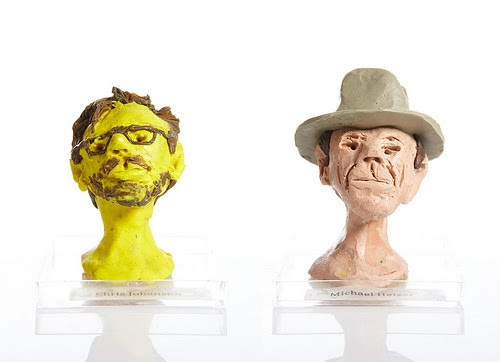 Work by BILL LIEBESKIND, in his show "We Make Art: 1,001 Artist Portraits'', at the Cape Cod Museum of Art, in Dennis, Mass., through June 14.
Work by BILL LIEBESKIND, in his show "We Make Art: 1,001 Artist Portraits'', at the Cape Cod Museum of Art, in Dennis, Mass., through June 14.
This artist has fashioned 1,001 heads of artists (including alive and long dead) from modeling clay. Incredibly, it took him only two years. Not surprisingly, he also makes comic books.
This project is educational in a number of ways. One is that it's way for people to see what famous artists whose faces are little known actually looked like. (The faces of only a few famed artists are well known, such as those of Andy Warhol and Salvador Dali.)
That might help viewers understand their personalities a bit more.
The museum's blurb says that, in addition to his art about fellow artists, he is "inspired by current events, such as the destruction of the World Trade Center and the dismantling of the Berlin Wall. Liebeskind attempts to make sense of the chaos in the world by using such powerful imagery in his work.''
Don't we all try to make sense of the world's chaos -- until, usually later in life, we give up trying?
'Mastery of the human condition'
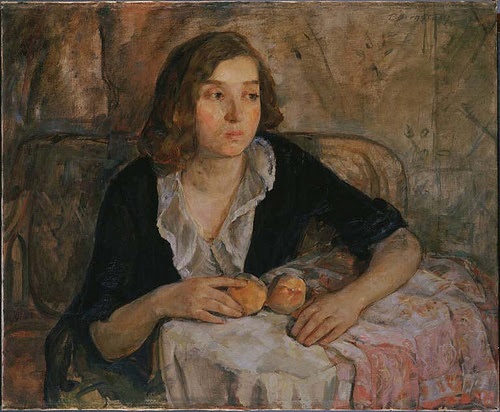 Girlhood'', by the late THERESA BERNSTEIN, in the show "Theresa Bernstein: A Century in Art'', at the Heftler Gallery, Beverly, Mass., through July 11.
Girlhood'', by the late THERESA BERNSTEIN, in the show "Theresa Bernstein: A Century in Art'', at the Heftler Gallery, Beverly, Mass., through July 11.
The show is meant to acquaint viewers with "her mastery of the human condition.''
As often is the case in these days of identity politics, Ms. Bernstein's relative obscurity is blamed on her being a woman and so not being given adequate respect and publicity. I don't know about that, but she certainly was a fine painter.
]
Summer folks vs. a would-be oyster farmer
Poor Richard Cook, the Mashpee, Mass., fisherman who wants to put in a little (two-acre) oyster farm a quarter mile off the summer homes of rich people in that Cape Cod town. He would seem to have gained the permits, etc., needed for the project, but..... The rich folks (who include the Krafts, who own the New England Patriots) are using every legal trick in the book and their influence in the Massachusetts legislature to stop what would be a very quiet, low key and environmentally friendly project that speaks to the the nifty idea of expanding one of New England most lucrative (and relatively few) cash crops -- shellfish. The persistent Mr. Cook has been trying to do the oyster farm since 2011 but failed to adequately consider the ability of a few well-heeled people to use America's stuck-in-molasses civil law and legislative Christmas-treeing to stop anything they don't like by making the lawyers' fees too expensive for most people.
In fact, such oyster farms used to be all up and and down the sandy sections of southern New England's coast. They were considered charming, a daily character-building example of hard work and a healthy connection to Mother Nature. They provided inspiration for many painters. Among other benefits, such shellfish farms help filter and clean the water. Popponesset Bay would be better having the oyster farm.
The summer gentry seek to create a bogus "marine sanctuary'' via a bill on Beacon Hill to cover the area where Mr. Cook wants to set up his oyster farm. (I suspect that these summer folks love to eat oysters -- from somewhere!) Sadly for Mr. Cook, he doesn't have the cash for campaign contributions that might get the attention of the most important solons.
Rich summer folks increasingly throw their weight around, and not just in their summer colonies, and many seem willing to stop anything in their sight that might remind them that other people have to make money, if not from "investments,'' even if it's in as traditional and healthy sector as shellfish aquaculture. (The battles against coastal wind turbines within distant sight of mansions is a more famous war.)
I have nothing against rick folks -- some of my favorite relatives and friends are in that clan! But I don't like grossly unequal application of influence.
Mr. Cook has already moved the proposed oyster farm a bit further away from the rich folks on, who often act as though they own everything from from their front porches to the oceanside horizon. But nothing is enough for people who think that they can buy anything.
Still, I suppose that it should be noted that town officials themselves seem to favor the farm, despite the big property taxes paid by the Krafts.
The ultimate respect?
"Odalisque,'' by ELMYR de HORY (1974, oil on canvas), in the style of Henri Matisse. Collection of Mark Forgy. (Photo by Robert Fogt ) at the Michele and Donald D'Amour Museum of Fine Arts, in Springfield, Mass. through April 27. It's in the "Deceive: Fakes and Forgeries in the Art World'' show.
Most of us are fakers in some way, and we build upon the work of others, albeit not usually to the point of trying to perfectly replicate it to show off and/or make money. This brilliant show will test the perceptions of authenticity and, the museum says, show how technology is used to determine fraud.
Laying a glove on Seekonk
'Pretty white gloves'
By PAUL STEVEN STONE
CAMBRIDGE
He sits on a folded-over cardboard box, slightly off-balance and without any visible sign of support other than the granite wall of the bank behind him and the few coins in the paper cup he shakes at each passerby.
Does he realize it is 4 degrees above zero, or minus 25 degrees if you factor in the wind that blows through the city and his bones with little concern for statistics? Does he notice the thick cumulus lifeforms that escape from his mouth in shapes that shift and evanesce like the opportunities that once populated his life?
Can he even distinguish the usual numbing effect of the cheap alcohol from the cruel and indifferent caress of this biting alien chill?
Too many questions, he would tell you, if he cared to say anything. But his tongue sits in silence behind crusted chapped lips and chattering teeth while half-shut eyes follow pedestrians fleeing from the bitter cold and his outstretched cup.
His gaze falls upon the hand holding the cup as if it were some foreign element in his personal inventory. Surprised at first to find it uncovered and exposed, especially in weather this frigid, he now recalls that someone at the shelter had stolen his gloves and left in their place the only option he still has in much abundance.
Acquiescence.
Examining the hand, and the exposed fingers encircling the Seven-Eleven coffee cup, he smiles in amused perplexity, murmuring to himself, “White gloves.”
Lifting his hand for closer inspection, he adds, “Pretty white gloves.”
An image of his daughter . . . Elissa, he thinks her name was . Yes, Elissa!, he recalls. An image of Elissa rises up in his mind, from a photograph taken when she was ten and beautifully adorned in a new Easter outfit: black shoes, frilly lavender dress and hat and, yes, pretty white gloves. The photo once sat on a table in his living room, but he couldn’t tell you what happened to it, nor to the table or the living room, for that matter. They were just gone. Swept away in the same tide that pulled out all the moorings from his life, and everything else that had been tethered to them.
The last time he’d seen Elissa she was crying, though he no longer remembers why. Must have been something he’d done or said; that much he knows.
“Pretty white gloves,” he repeats, staring at his hand.
He recalls the white gloves from his Marine dress uniform. At most he wore them five times: at his graduation from officer’s training school, at an armed services ball in Trenton, New Jersey, and for three military funerals. There was never a need for dress gloves in Vietnam. They would have never stayed white anyway; not with all the blood that stained his hands.
Out of the corner of his eye he can see a policeman walking towards him and instinctively hides his cup, some vestige of half-remembered pride causing him to avert his gaze from the man’s eyes at the same time.
“We need to get you inside, buddy,” the officer says. “You’ll die of cold, you stay out here.”
Moments later, a second police officer, this one a woman, steps up to join them.
“That’s the Major,” she tells her colleague. To the seated figure she offers a smile.
“You coming with us, Major?”
“Go away,” he answers, looking up as he leans further against the cold granite wall. “Don’t need you. Don’t need no one.”
“Can’t leave you out here,” the first officer says. “We’ve got orders to bring you and everyone else in.”
“Leave me alone!” the seated man shouts, gesturing with his hands as if he could push them both away.
“Oh shit,” the female officer says under her billowing breath. To her partner she whispers, “His hands. Look at his hands.”
Quickly recognizing the waxy whiteness for what it is, the officer shrugs, “Guess we’re a little late.”
To the man on the sidewalk, he offers, “That’s frostbite, buddy.”
“No,” the seated man protests. He holds up both hands, numb and strange as they now feel and offers a knowing smile of explanation.
Just like the Marine officer he once was, just like the sweet innocent daughter he once knew, just like the young man grown suddenly old on a frozen sidewalk, his hands are beautiful and special in a way these strangers will never understand.
“White gloves,”he insists proudly.
“Pretty white gloves.”
Paul Steven Stone is a Cambridge-based writer. His blog, from which this comes, is www.paulstonesthrow.com.


